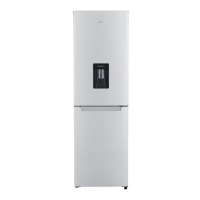13
Defrosting Frozen Food
• Take the frozen food out from the freezer compartment and uncover the frozen food. Let
it defrost at room temperature. Don’t forget that defrosting in a warm area encourages the
growth of bacteria and low temperature cooking may not destroy dangerous bacteria.
• Drain o and throw away any liquid lost during defrosting.
• Always make sure there are no ice crystals in the food before cooking, particularly with meat.
These crystals indicate that the food has not fully defrosted.
• Cook food as soon as possible after defrosting.
• Many microwaves and ovens have a defrost setting. To avoid bacterial build up, only use
these if you intend to cook the food immediately afterwards.
Filling the Water Tank
1. Ensure the water tank is securely in place before
lling with water.
2. Open the lid found on the water tank balcony.
3. Fill water tank to the MAX level indicated, then close
the lid. Filling above the MAX level may cause water
to overow when closing the lid.
Using the Water Dispenser
The water dispenser is located in the front of the upper
door.
Place a cup under the outlet and gently push against
the dispenser level. Ensure the cup is lined up with the
dispenser to prevent spillage.
Never re-freeze anything that has been defrosted unless you cook it again, to kill o
harmful bacteria. Never re-freeze defrosted shellsh. Re-seal packs properly after
removing items. This prevents drying or freezer-burn and a build up of frost on any
remaining food.
Water Dispenser
Lever
Water Overow
Tray
• Always ensure the water tank is securely attached before use.
The water dispenser may not function correctly if water tank is not secured.
Do not use the refrigerator without the water tank.
• After each use, small amounts of
water may drip from the water
dispenser. This is normal.
The excess water will collect in the water
overow tray. Empty the water overow
tray periodically to prevent spillage.
LFFD55S18_IB_RC_200716_grace.indd 13LFFD55S18_IB_RC_200716_grace.indd 13 16/7/2020 8:00 PM16/7/2020 8:00 PM

